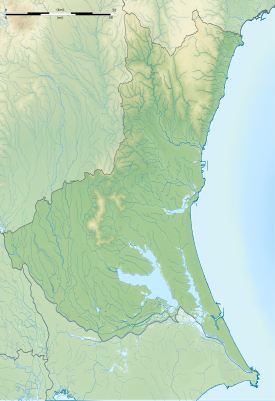Koga Castle
| Koga Castle | ||
|---|---|---|
|
Koga Castle, wall of the Suwa area |
||
| Creation time : | 1455 | |
| Castle type : | Hirajiro (Lower Castle) | |
| Conservation status: | little received | |
| Place: | Koga | |
| Geographical location | 36 ° 11 '12.8 " N , 139 ° 41' 43.7" E | |
|
|
||
The Koga Castle ( Japanese 古河 城 , Koga-jō ) is located in the city of Koga in Ibaraki Prefecture . In the Edo period , the Doi last resided there as a larger Fudai daimyo .
Lords of the castle in the Edo period
- From 1601 a branch of Toda with an income of 20,000 koku ,
- from 1612 a branch of the Ogasawara with 20,000 koku,
- from 1619 a branch of Okudaira with 110,000 koku,
- from 1622 a branch of the Nagai with 72,000 koku,
- from 1633 a branch of the Doi with 160,000 koku,
- from 1681 a branch of the Hotta with 90,000 Koku,
- from 1685 a branch of the Fujii-Matsudaira with 90,000 koku,
- from 1694 a branch of Ōkōchi with 70,000 koku,
- from 1712 a branch of the Honda with 50,000 Koku,
- from 1759 the Matsui with 50,000 Koku,
- from 1782 again a branch of Doi with 70,000 koku.
history
In 1455 moved Kamakura Kubō (governor of the shogun for Kantō ) Ashikaga Shigeuji ( 足 利 重 氏 ; 1434-1497) to Koga and built a castle there. It was since then the seat of the Koga-Kubō to Ashikaga Yoshiuji ( 足 利 義 氏 ; 1541–1583) as the last Koga-Kubō. Then the castle came temporarily under the rule of the Later Hōjō .
After Tokugawa Ieyasu had taken over the Kanto provinces in 1590 , the castle was occupied by a branch of the Ogasawara, which the Toda followed in 1601. When the castle came to Doi Toshikatsu ( 土井 利 勝 ; 1573–1644) in 1633 , he renewed and expanded the castle. The castle tower ( 天 守 , tenshu ; red), which protected the innermost area, came from this time . The somewhat remote front area, the Suwa-guruwa ( 諏 訪 曲 輪 ; S), was also created at that time. This was followed by a number of other daimyo, until then with Toshisato ( 利 里 ; 1722–1777) a Doi took over the castle again. The Doi then remained lords of the castle until the Meiji Restoration in 1868. - Many of the lords of the castle performed important functions within Bakufu.
The attachment
The Koga Castle was located on a strip of land extending from north to south, which was protected in the west by the river Watarase ( 渡 良 瀬 川 , -gawa ) and in the east and south by marshland. The central area, the Hommaru ( 本 丸 ; 1), is joined in the west by the second area, the Ni-no-maru ( 二 の 丸 ; 2) and in the north by the third area, the San-no-maru ( 三 の 丸 ; 3) , on. In the north the pre-areas Marunouchi-guruwa ( 丸 の 内 曲 輪 ) and Kannonji-guruwa ( 観 音 寺 曲 輪 ) were built. To the east this protected the elongated, narrow Higashiobi-guruwa ( 東 帯 曲 輪 ), in the south the Yorimasa-guruwa ( 頼 政 曲 輪 ; Y) and the Tatsuzaki-kuruwa ( 辰 崎 曲 輪 ).
Today only remnants of the ramparts remain from the castle. The Inui gate ( 乾 門 , Inui-mon ) of the second castle area was taken over from the temple Fukuhō-ji ( 福 法 寺 ).
Remarks
- ↑ The designation Inui ( 乾 or 戌 亥 ) indicates the location in the northwest after the twelve branches of the earth .
literature
- Sugai, Yasuo: Koga-jo in: Miura, Masayuki (Ed.): Shiro to jinya. Tokoku-hen. Gakken, 2006. ISBN 978-4-05-604378-5 , p. 100.


